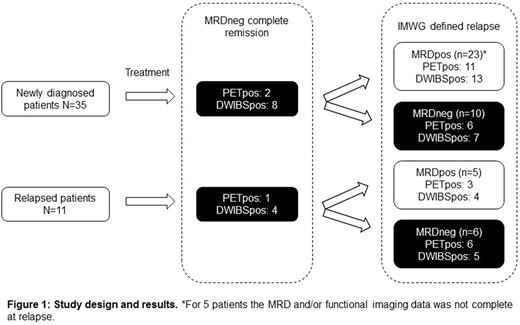Abstract
Introduction
Novel agents have dramatically increased the rate of complete remission (CR) in patients with multiple myeloma (MM). As a result, the quality of CR is increasingly being assessed by molecular tests, such as multicolor flow cytometry (MFC) or next generation sequencing. In this context, the achievement of minimal residual disease negativity (MRDneg) has been reported to be associated with favorable outcomes, and recently it has been included as an additional criterium in the international myeloma working group (IMWG) response definition. Despite this, even MRDneg patients continue to relapse, probably due to residual disease at sites other than the one commonly investigated for MRD, the posterior iliac crest. In this work we have determined whether functional imaging can be used to detect residual disease in MRDneg patients and to address its value in the assessment of patients in CR. To investigate this we selected a unique group of patients who had relapsed from MRDneg CR and for whom two different functional imaging techniques were performed at the MRDneg CR stage and later at IMWG defined relapse.
Methods
Of 294 patients treated with novel agents and autologous stem cell transplantation who had achieved MRDneg CR, assessed using 8 color MFC with a limit of detection between 10-4 and 10-5, we identified 46 who subsequently relapsed. Of these 62% were male with a median age of 64 (41-79) years, and 22% had unfavorable molecular features at baseline. 35 patients were newly diagnosed and achieved MRDneg CR during frontline therapy. The remaining 11 patients achieved MRDneg CR following salvage therapy post-relapse. The functional imaging tests used were 18F-FDG positron emission tomography with CT attenuation correction (PET-CT) and diffusion-weighted magnetic resonance imaging with background suppression (DWIBS). Using PET-CT, a FL was defined as a circumscribed focus with increased FDG uptake compared to its surroundings. For DWIBS, a FL was defined as a well delineated focal intensity above the surrounding background BM ≥1 cm in size and showing restriction on apparent diffusion coefficient maps.
Results
At the time of MRDneg CR, functional imaging showed residual focal disease in 14 patients (30%). This is a surprisingly high number, which reflects our approach of focusing on patients who subsequently relapsed. For PET-CT, which measures the uptake of radioactive glucose, focal lesions were seen in 3 of 46 patients. DWIBS, which quantifies diffusion of water molecules, showed FLs in 12 patients (26%). This increased rate indicates that DWIBS is the more sensitive technique for this purpose. Interestingly, 9 of the 14 FL-positive patients exclusively presented with FLs outside the pelvis or contra-laterally to the site investigated for MRD detection, explaining the discordant results. Of note, in 7 of 14 patients FLs detectable at MRDneg CR progressed in size or restriction, strongly suggesting that residual clonal cells at these sites led to relapse. In 6 other patients there were either no FLs (n=3) or only new FLs (n=3). This observation indicates that the kinetics of achieving molecular MRD and imaging MRD may differ. At relapse 16 of the 44 patients (36%) remained MRDneg yet 13 were positive by at least one of the functional imaging techniques. Only 2 of these cases presented with FLs at the pelvic site of BM biopsy used for MRD detection. Interestingly, there was a trend to a higher proportion of the imaging-pos/MRDneg status in patients at later relapses compared to the ones at first relapse (Fisher's test P =0.06).
Conclusions
Functional imaging improves assessment of residual disease by accounting for the heterogeneous disease distribution in MM. The patchy character of MM BM involvement seems to increase after the first relapse, reducing the sensitivity of MRD diagnostics done exclusively on iliac crest samples. The sensitivity of DWIBS for detection of focal residual disease seems to be superior to PET-CT. However, future research is warranted to address the specificity of DWIBS, the glycolytic rate of residual MM cells and the potential suppression of FDG uptake by ongoing treatment. To further assess the specificity of functional imaging as a tool to predict relapse, we will analyze a set of 248 MM patients who remain in MRDneg CR and the results will be presented in the meeting.
Barlogie: Millenium Pharmaceuticals: Consultancy, Research Funding; Celgene Corporation: Consultancy, Research Funding. Davies: Bristol-Myers: Consultancy, Honoraria; Takeda: Consultancy, Honoraria, Membership on an entity's Board of Directors or advisory committees; Celgene: Consultancy, Honoraria, Membership on an entity's Board of Directors or advisory committees; Seattle Genetics: Consultancy, Honoraria; Amgen: Consultancy, Honoraria. Morgan: Bristol Myers: Consultancy, Honoraria; Takeda: Consultancy, Honoraria; Celgene: Consultancy, Honoraria, Research Funding.
Author notes
Asterisk with author names denotes non-ASH members.


This feature is available to Subscribers Only
Sign In or Create an Account Close Modal